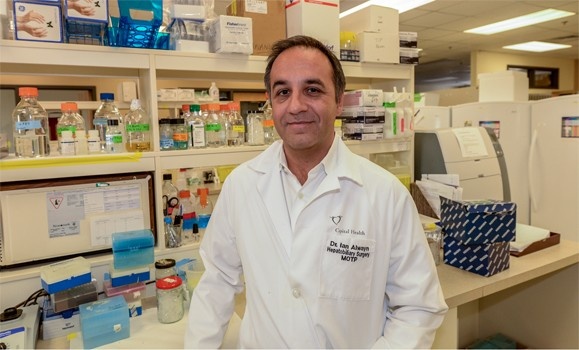Media Releases
» Go to news mainDalhousie medical researchers tackle silent epidemic of fatty liver disease

HALIFAX, N.S. - April 8, 2015 - Non-alcoholic fatty liver disease is now the most common form of liver disease in Canada and part of a larger liver-disease epidemic.
“We suspect that 25 to 40 per cent of the adult population has fatty liver to some degree, while about 5 per cent of adults have fatty livers that have progressed to the point of inflammation, known as steatohepatitis,” says hepatologist Dr. Kevork Peltekian, professor and head of the Division of Digestive Care & Endoscopy at Dalhousie Medical School. “Fatty liver has surpassed alcohol as the leading cause of liver disease.”
Fatty liver disease is a silent epidemic, because there are usually no symptoms until the damage is beyond repair. “Fatty liver is most often identified when people are having ultrasound or MRI investigations for another reason,” Dr. Peltekian says. “Right now, the only way to know for sure if they have inflammation is to do a liver biopsy, but the numbers of patients are so high, this would overwhelm the health care system.”
According to the Canadian Liver Foundation, deaths from all forms of liver disease rose by an astounding 30 per cent in eight years prior to the 2013 release of its report, Liver Disease in Canada: A Crisis in the Making.
The treatment for fatty liver disease is not a medication. “There’s no magic potion,” says Dr. Peltekian. “People with fatty livers need to control their blood sugar and lose weight—it’s not about fat in the diet, it’s about excess calories and sugars that are converted to fat and stored in the liver.”
Fortunately, liver cells can regenerate themselves, so fatty liver disease is reversible if it has not progressed too far. Once the liver is heavily scarred, however, it can no longer heal itself. In this case, the person may develop cirrhosis, liver cancer or even liver failure.
Dr. Peltekian is one of several members of Dalhousie Medical School’s faculty who are alarmed by rising rates of fatty liver disease in the Maritimes. Radiologist Dr. Sharon Clarke and transplant surgeon Dr. Ian Alwayn share his concern. All three are taking the lead on research projects to address the issue:
- Dr. Peltekian and his colleagues in hepatology, nursing, nutrition and exercise science are testing a new approach to managing fatty liver disease. Rather than seeing a specialist when first diagnosed with fatty liver, people attend a three-hour group session (a Fatty Liver Forum) led by the team of professionals, where they gain in-depth information about the disease and how they can stop or reverse it. “We believe the Fatty Liver Forum will achieve better results for patients, with far more efficient use of limited health care resources,” Dr. Peltekian says. “If patients have not met their weight-loss target after nine months, then we proceed to liver biopsy and work with them more intensively to prevent additional damage and liver failure.”
- Dr. Clarke is working with fellow Dalhousie radiologist, Dr. Steven Beyea, and his team at BIOTIC (Biomedical Translational Imaging Centre) to develop new MRI algorithms that will reveal much more information about fatty livers than current MRI technologies can. “The new algorithms will enable us to see how much and what kinds of fat are in the liver, so we can more accurately predict if a person is at risk of serious liver disease, without a biopsy,” says Dr. Clarke. “These are the people who require the most urgent attention.”
- The only treatment for liver failure is liver transplant, but more patients are dying while waiting for a donor liver, in part because the availability of healthy donor livers is declining as rates of fatty liver in the general population rise. Dr. Alwayn and his team are looking for ways to make fatty livers more suitable for transplant. They’ve invented a new technology that allows them to infiltrate the liver with protective agents, so it can better withstand the injuries that take place during the transplant process. “If we can protect fatty livers from these injuries, we will be able to use a lot of organs that would otherwise not be suitable for transplant,” says Dr. Alwayn, QEII Foundation Endowed Chair in Transplantation Research and head of the Multi-Organ Transplant Program at the QEII. Dr. Alwayn is also exploring the possibility of de-fatting fatty livers prior to transplant, with Dalhousie lipid scientist, Dr. Neale Ridgway. They’re co-supervising a second-year medical student, Melissa Wallace, on a project to see if their experimental system for metabolizing fat in the donor liver prior to transplant can help the organ function well after transplant.
For more information about fatty liver disease research at Dalhousie Medical School, see the feature article here.
-30-
Media Contacts
Cory Burris
Dalhousie Medical School Communications
cory.burris@dal.ca
1-902-494-4247
Melanie Jollymore
melaniejollymore@eastlink.ca
1-902-827-3126
Comments
comments powered by Disqus
Recent News
- Media release: Nova Scotia pharmacists among Canada’s first to prescribe HIV prevention drug with help from Dalhousie pilot study
- Media opportunity: What do you need to make a hit song? Math, according to a Dalhousie University mathematician who created a pop song using fractals, the cantor set and all things mathy
- Media opportunity: Uncovering the link between meltwater and groundwater in mountain regions is a priority for sustainable water management: international research paper
- Media opportunity: Fish biomass faces steep declines by end of century under high‑emissions scenario: FAO report by Dalhousie University, international scientists
- Media Release: Two Dalhousie students selected as McCall MacBain International Fellows
- Media release: Barriers to care ‑ research reveals the experiences of transgender and gender‑diverse people seeking health care
- Media opportunity: Being involved in extracurricular activities really does matter when it comes to 'mattering': Dalhousie University research
- Media opportunity: Podcast by Dalhousie researcher and Halifax photographer looks at barriers to Nova Scotia's coastline, decreasing access to waterfronts and problems with litter, marine debris in public coastal areas
